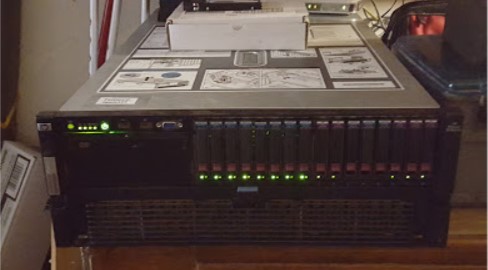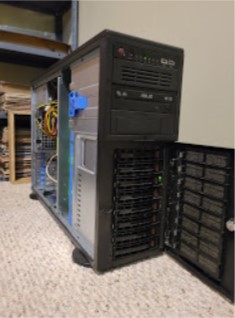Several years ago I was able to get my hands on an old HP DL580 Gen 8 from a server resupply store. Initially I just installed Redhat Linux on the system and used that for some script development, testing and later a plex media server. This server had the added benefit of heating much of the house and drowning out any arguments my kids had. 🙂

[Old Server: 24 core DL580 Gen 8, 16*500GB SAS, 128GB RAM]
Alas, it was time for a new machine and I decided I could build one from scratch that would last far into the future for my needs. I wanted the machine to handle several VM’s for development as well as my new media server and cloud management software. After some shopping around I settled into the following configuration knowing that I should would not be needing additional horsepower for many many years to come.
My New Pride and Joy 🙂

- ASRock Dual LGA 2011 Socket Motherboard (EP2C606-2L/D16)
- CPU(s) 48 x Intel(R) Xeon(R) CPU E5-4657L v2 @ 2.40GHz (2 Sockets)
- DELL DDR3 1600MHz Buffered ECC Memory (256GB)
- 2 Mirrored 1TB SSD’s for the the OS (Debian/Proxmox using ZFS)
- 5 6TB NAS drives in a ZFS raidz2 for ~27TB Data Storage
- 1 6TB NAS drive used as a temp/scratch pool
- All packed in a SUPERMICRO CSE-743TQ-865B-SQ 8 Bay tower.
The initial plan was to use Proxmox Virtual Environment to host the VM’s to allow for segregation and security. This worked well to some degree but I found that I spent a great deal of storage space on VM’s for only a few applications. In addition because sharing storage between VM’s at the host layer is not practical, presentation of shared filesystems leveraged CIFS and NFS which reduced network throughput greatly. Eventually I settled on running Proxmox for just a few VM’s and Docker containers for the rest. (True i could have used LXC containers but the Docker word has far wider utilization and therefore in my opinion better support. So when It came time to add storage to the server I settled into my current configuration.
Proxmox as the VM Environment Manager
VM’s:
- 1 bare bones locked down server to allow SSH access to guests for inbound shares syncing
- 1 Windows VM for GUI windows software and apps.
- 1 Linux desktop for GUI applications when desired.
Docker, Docker Compose, Portainer (GUI Admin)
- Database stack (Postgres, mysql, mariadb, influxdb)
- Media Search Stack (to find new movies etc)
- Media Server Stack (PLEX, Handbrake to encode OTA recordings)
- Home Cloud Stack (Nextcloud etc)
- Admin Stack (Proxy, lets encrypt and GUI management tools and Metrics)
It may also be good to note that I have an external Netgate appliance running pfSense serving as a Firewall, DNS and Router allowing some ease in configuring applications and sites via the proxy. But more on that later…
In my next home lab post, I will cover the installation of Proxmox and Docker on ZFS as well as some of the pitfalls to be aware of.
Hi, this is a comment.
To get started with moderating, editing, and deleting comments, please visit the Comments screen in the dashboard.
Commenter avatars come from Gravatar.